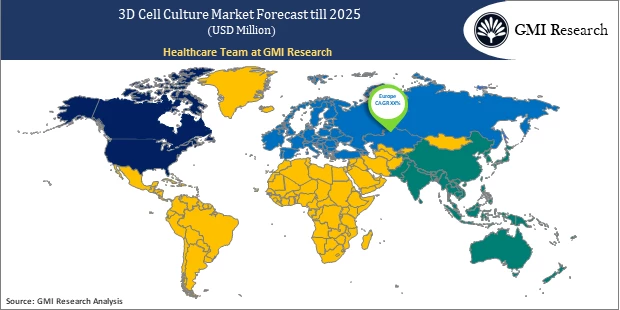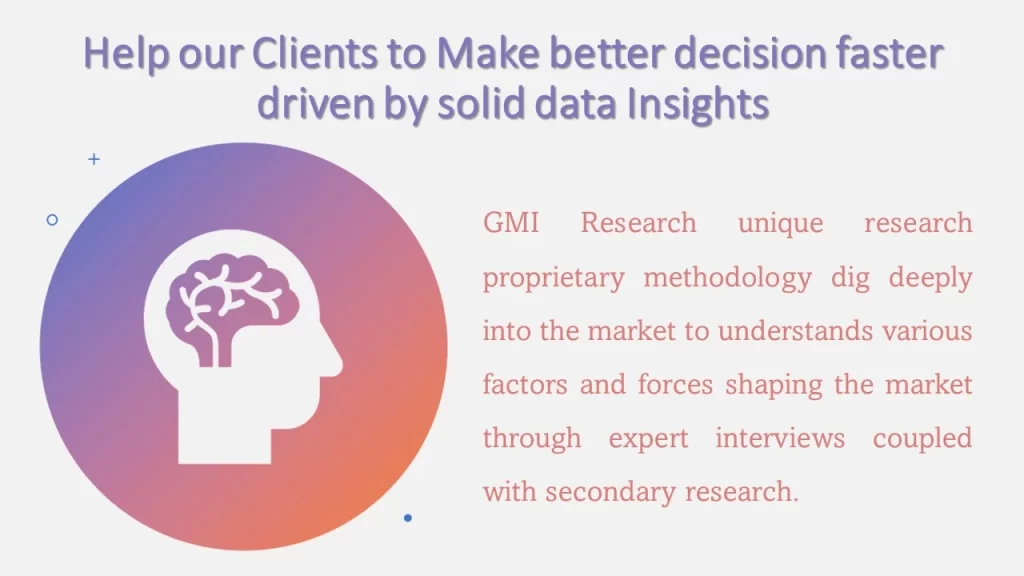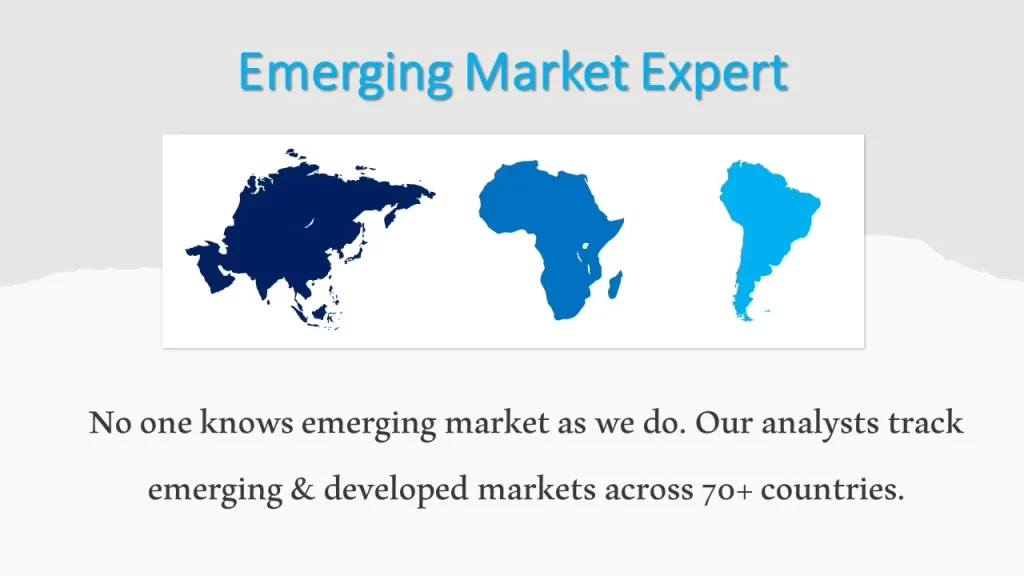3D Cell Culture Market Share, Size, Statistics, Growth Opportunities & Global Industry Forecast Report, 2022-2029
Global 3D Cell Culture Market by Technology [Scaffold-free (Low Attachment Surfaces, Hanging Drop Method, 3D Petri Dishes, 3D Bioreactors), Scaffold-based (Hydrogels, Porous Scaffolds, Fibrous Scaffolds, Micropatterned Surfaces), Others], by Application (Drug Discovery & Toxicology, Cancer Research, Stem Cell Research, Tissue Engineering) and by Geography
Analysis from GMI Research finds that the 3D Cell Culture Market earned revenues of USD 1,600 million in 2021 and estimated to touch USD 4,047 million in 2029 will grow at a CAGR of 12.3% from 2022-2029.
To have an edge over the competition by knowing the market dynamics and current trends of “3D cell culture market”, request for Sample Report here
Key Drivers
Increasing usage of 3D cell cultures in the applications including toxicology testing, drug discovery, cancer treatment, and stem cell research is the major driving factor stimulating the 3D cell culture market size. Rising application of 3D protocols in biological research and product innovation will further propel the 3D cell culture market growth. For example, in December 2020, eNUVIO Inc., introduced EB-Plate, a completely reusable microplate for 3D cell culture. This will reduce the wastage of single-use plastics, expand the utility of 3-dimensional microplates, and propel zero-waste movement in laboratories. Further, growing focus on discovering substitutes to animal testing in toxicology studies, rising incidences of chronic disorders and availability of research funding are projected to boost the 3D cell culture market size.
Do you want to know more about the Research process and detailed Methodology, Request Research Methodology of this report
Technology Segment Analysis
Scaffold-based technology is projected to witness a faster CAGR over the forecast period, owing to its ability to change the mechanical and biochemical properties depending upon the need of application. Increasing use of scaffold-based technology in drug discovery and cell expansion due to the structural choices, ease of imaging and availability of a variety of materials will further expand the market growth. The integration of advanced biomechanical and mechanical signs as an imitator of native extracellular matrix aided by the use of hydrogels as scaffolds in 3D cell culture has driven the demand for technology. For example, In January 2021, researchers across the Southern University of Science and Technology, China launched a method for 3D printing of highly stretchable hydrogels to overcome the limitations concerned with the performance and functionality of hydrogel-polymer-based scaffolds.
Application Segment Analysis
Cancer research application is forecast to dominate the 3D cell culture market over the coming years, owing to the use of 3D cellular models in preclinical testing and screening to improvise the knowledge of cancer biology. 3D cell culture offers various benefits in cancer research including indicating realistic drug response, enabling experimental manipulation in cell behavior, and easy alteration in cell morphology driving the segment’s size.
In case, any of your pain points areas are not covered in the current scope of this report, Request for Free Customization here
Regional Analysis
North America is projected to expand at the highest rate over the forecast period, primarily because of the increasing healthcare expenditure and availability of private and government allowance. Also, the expansion across pharmaceutical and biotechnological companies has resulted in the innovation of sophisticated items, which will augment the market growth over the upcoming years. Various pharmaceutical and biotechnology companies in the region are using culture technology in partnership with research institutes and clinical laboratories to develop regenerative medicines.

Top Market Players
Various prominent players operating in the 3D cell culture market include 3D Biotek, AMSBIO, Corning Lifesciences, Synthecon, MilliporeSigma, Thermo Fisher Scientific, and Nanofiber Solutions among others.
Key Developments
-
- In 2021, Lonza Group AG and CN Bio Innovations decided to enter in a distribution agreement providing pre-sanctioned hepatocytes for use on CN Bio’s innovative PhysioMimix Organ-On-a-Chip (OOC) range of single and multi-organ microphysiological systems (MPS).
- In 2021, Amerigo Scientific introduced 3D Cell Culture for scientific uses to expand its cell culture portfolio. This new 3D cell culture system is used in research areas which include medicine, drug discovery, evaluation of nanomaterials, and basic life science.
- In 2021, Jellagen Limited, a biotechnology company innovated JellaGel Hydrogel, a 3D hydrogel. JellaGel that provides a non-mammalian, natural, biochemically simple, consistent, and easy-to-use hydrogel to customers.
- In 2021, Thermo Fisher Scientific Inc. decided to spend USD 600 million to expand its bioprocessing production capabilities across Americas, Europe, and Asia.
Segments covered in the Report:
The global 3D cells culture market is segmented on the basis of technology, application, and geography:
For detailed scope of the “3D cell culture market” report request a Sample Copy of the report
Key questions answered in this research report:
-
- At what pace is 3D cells culture market growing? What will be growth trend in future?
- What are the key drivers and restraints in the current market? What will be the impact of drivers and restraints in the future?
- What are the regional revenue and forecast breakdowns? Which are the major regional revenue pockets for growth in the 3D cell culture market?
- What are the various product/ technology areas and how they are poised to grow?
- What are the various application areas and how they are poised to grow?
|
Report Coverage |
Details |
| Market Revenues (2021) |
USD 1,600 million |
| Market Base Year |
2021 |
| Market Forecast Period |
2022-2029 |
| Base Year & Forecast Units |
Revenues (USD Million) |
| Market Segment | By Technology, By Application, By Region |
| Regional Coverage | Asia Pacific, Europe, North America, and RoW |
| Companies Profiled | 3D Biotek, AMSBIO, Corning Lifesciences, Synthecon, MilliporeSigma, Thermo Fisher Scientific, and Nanofiber Solutions among others.; a total of 7 companies covered. |
| 25% Free Customization Available | We will customize this report up to 25% as a free customization to address our client’s specific requirements |
Market Segmentation
Global 3D Cells Culture Market by Technology
-
- Scaffold-free
- Low Attachment Surfaces
- Hanging Drop Method
- 3D Petri Dishe
- 3D Bioreactors
- Scaffold-based
- Hydrogels
- Porous Scaffolds
- Fibrous Scaffolds
- Micropatterned Surfaces
- Others
- Scaffold-free
Global 3D Cells Culture Market by Application
-
-
- Drug Discovery & Toxicology
- Cancer Research
- Stem Cell Research
- Tissue Engineering
-
Global 3D Cells Culture Market by Region
-
- North America Silicone Gel Market (Option 1: As a part of the free 25% customization)
- By Technology
- By Application
- US Market All-Up
- Canada Market All-Up
- Europe Silicone Gel Market (Option 2: As a part of the free 25% customization)
- By Technology
- By Application
- UK Market All-Up
- Germany Market All-Up
- France Market All-Up
- Spain Market All-Up
- Rest of Europe Market All-Up
- Asia-Pacific Silicone Gel Market (Option 3: As a part of the free 25% customization)
- By Technology
- By Application
- China Market All-Up
- India Market All-Up
- Japan Market All-Up
- Rest of APAC Market All-Up
- RoW Silicone Gel Market (Option 4: As a part of the free 25% customization)
- By Technology
- By Application
- Brazil Market All-Up
- South Africa Market All-Up
- Saudi Arabia Market All-Up
- UAE Market All-Up
- Rest of world (remaining countries of the LAMEA region) Market All-Up
- North America Silicone Gel Market (Option 1: As a part of the free 25% customization)
Global 3D Cells Culture Market Competitive Landscape
-
- Major Players and their Key Strategies
- New product launches
- Mergers and acquisitions
- Collaborations, partnerships, agreements and joint venture
Frequently Asked Question About This Report
3D Cell Culture Market [HM11A-00-0918]
3D Cell Culture Market is anticipated to grow at 12.3% CAGR during the forecast period.
The 3D cell culture market growth is mainly driven by increased oncology drug discovery studies, rising investments in the field, favourable government policies and support, and the use of 3D cell cultures as an alternative to animal testing in toxicology studies.
The Various prominent players operating in the 3D cell culture market include 3D Biotek, AMSBIO, Corning Lifesciences, Synthecon, MilliporeSigma, Thermo Fisher Scientific, and Nanofiber Solutions among others.
The various Technology segments in the 3D cell Culture Market include Scaffold-free (Low Attachment Surfaces, Hanging Drop Method, 3D Petri Dishes, 3D Bioreactors), Scaffold-based (Hydrogels, Porous Scaffolds, Fibrous Scaffolds, Micropatterned Surfaces), and Others.
- Published Date: Sep-2021
- Report Format: Excel/PPT
- Report Code: HM11A-00-0918
Licensing Options
Single-User License:
The report is used by the purchaser (One Individual) only
Multi-User License:Report is shared with maximum 5 users (employees) including the purchaser of the purchasing corporation only
Corporate License:
Report is shared with unlimited user (employees) of the purchasing corporation only
The report is used by the purchaser (One Individual) only
Multi-User License:Report is shared with maximum 5 users (employees) including the purchaser of the purchasing corporation only
Corporate License:
Report is shared with unlimited user (employees) of the purchasing corporation only
3D Cell Culture Market Share, Size, Statistics, Growth Opportunities & Global Industry Forecast Report, 2022-2029
$ 4,499.00 – $ 6,649.00
Why GMI Research







